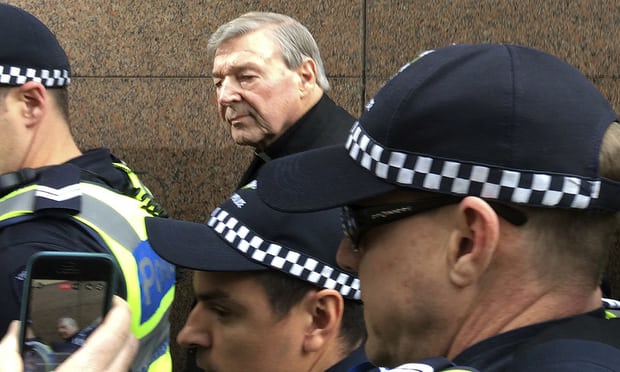Secrecy and Security Envelop George Pell's Magistrates Court Show
By David Marr
My apologies. I canít tell you whatís going on. A great billowing, lace-edged cloak of secrecy still surrounds the case of the Director of Public Prosecutions v. G Pell. Months down the track, we donít know what the charges are. Even if they fell into my lap, I would not say a word. Why not? Sorry, thatís a secret too. Old timers round the Melbourne courts canít remember the last time the public was left so much in the dark before a great criminal trial. It was certainly baffling for the press of the world who gathered outside the Melbourne magistrates court before dawn for what is usually one of the dreariest rituals of the criminal law: a filing hearing. But this was entirely Cardinal Pellís show. He didnít need to turn up at all and we were only there because he wanted to brave the cameras. Twelve were lined up along the gutter by the time the sun came up. The queue of reporters at the door of the courts went half-way down the wheelchair ramp. Pell hove in sight a little before 9am dressed all in black with a black overcoat over his arm and black brogues on his feet. He was entirely impassive. Businesslike. Obedient. He did what he was told. The guards spared him the queue and the security gate but frisked him with an electronic wand. The result was a brief but uncomfortable tableau as Pell was directed to raise his arms to shoulder height. He stopped short of the full crucifixion. A claque of supporters from St Paulís, Coburg, applauded as he strode through the foyer. ďWeíre Catholics,Ē explained Trevor Atkinson. ďWe know George.Ē A few feet away, Julie held up a Madonna and Child in pastel blue as she had since first light. ďI support the survivors and victims of Catholic church child abuse,Ē she explained. She was resigned to putting the painting through the X-ray machine. Just in case. Nothing was left to chance. The cardinalís name was not on the court list. It went: Pang, Pierce, Pera Ö but no Pell. And in the face of the biggest crowd the courts had seen for years, some diligent official decided to use a courtroom so small that only 50 spectators could watch the proceedings in the flesh. We sat waiting in absolute silence. Every time the door opened a gust of fierce noise blew in from the foyer. But when it shut again we were left in this clammy quiet. We were not only journalists. The campaigner Chrissie Foster, widow of Anthony, sat on watch as she has for years through trials and royal commissions since the abuse scandal broke over the church. Pell appeared with his lawyers. He was not impassive now but stunned. He seemed alone, in some vast space of his own making. He picked lint from his trousers and murmured once or twice to his barrister, Robert Richter QC. Otherwise he just sat. Five artists worked away: heads up, heads down, charcoal flying. Their only focus was Pell. A month ago this man was a power in the Vatican. Now heís sitting in an ordinary room in an everyday court on the corner of William and Lonsdale Streets, Melbourne. Thatís one hell of a journey. Richterís beard and owl glasses are his trademark. He has been on Pellís case since at least last October. That the cardinal was charged was a defeat for Richterís team for they had worked hard to persuade the police not to take that step. But the secrecy enveloping the proceedings is a mark of Richterís great skill. No one underestimates this man. The word is that Richter will ask for at least three separate trials. They would almost certainly involve continued restrictions on reporting both of the charges and of evidence. It may be 2020 before the full story Ė either of acquittal or conviction Ė can be told. But first Pell must be committed for trial. Itís by no means certain. If heís not, heís free to go. When the magistrate Duncan Reynolds appeared on the dot of 10am, almost the only chore he had was to set the timetable for the months ahead. On 6 October the lawyers will regroup to discuss progress with the committal itself not expected until well into the new year. Richter forewarned the magistrate that when the time comes his client ďwill plead not guilty to all the charges and will maintain the presumed innocence he hasĒ. Meanwhile, all the restrictions on reporting the case remain in place. I was planning at this point to assess claims widely made on Pellís behalf that an eminent man charged after much public reporting of allegations against him, canít face a fair trial. Not any more. The prosecutor, Andrew Tinney SC, read a stern warning to the press: ďAny publication of material speculating about the strength or otherwise of the case, the prospect of a fair trial or trials being had, whether the accused should or should not have been charged, the likelihood of conviction or acquittal, or any other such matters would be in contempt of court.Ē He continued: ďThe director of public prosecutions has already had cause to write to a number of media organisations in respect of articles which appeared to be in breach of the principles.Ē We are warned. After a little under six minutes, the magistrate adjourned. Ten police escorted Pell through the foyer. I thought this a little exaggerated. But the cardinal needed every one of them caught in a crush of photographers and demonstrators as he took the short journey round the corner to the safety of Richterís chambers.
|
.
Any original material on these pages is copyright © BishopAccountability.org 2004. Reproduce freely with attribution.
